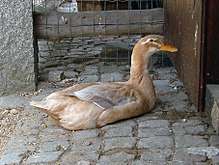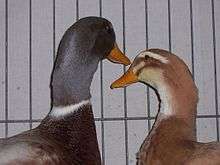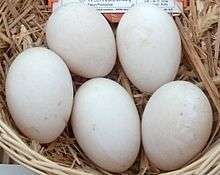Saxony duck
 duck in Görlitz Zoo, Görlitz, Saxony | |
| Other names | German: Sachsenente |
|---|---|
| Country of origin | Germany |
| Use | eggs, meat, fancy |
| Traits | |
| Weight | |
| Egg color | white[1] |
| Classification | |
| APA | heavy duck[2] |
| EE | yes[3] |
| PCGB | heavy[4] |
| |


The Saxony, German: 'Sachsenente', is a German breed of domestic duck. It was bred in Saxony in the 1930s, but because of the Second World War was recognised only in 1957.
History
The Saxony was bred in the 1930s by Albert Franz of Chemnitz, in the Free State of Saxony, by cross-breeding German Pekin, Blue Pomeranian and Rouen birds, and was first shown at Chemnitz-Altendorf in 1934. Almost all of the original stock was lost during World War II. After the War, Franz started breeding again from the remaining stock.[5]:445
The Saxony was officially recognised in East Germany in 1957, in West Germany in 1958.[5]:445 Birds were taken to Switzerland in 1965 and to France in 1968.[6]:1 The Saxony was recognised in the United Kingdom in 1982.[5]:445 Some were imported to the United States by David Holderread in 1984; the Saxony was admitted to the Standard of Perfection of the American Poultry Association in 2000.[7]:98
In 2013 the total number in Germany was 1173.[8] In North America, the breed is listed as "threatened" by the American Livestock Breeds Conservancy.[9]
Characteristics
The Saxony is a heavy duck: drakes weigh about 3.5 kg, ducks about 3.0 kg. It is muscular and close-feathered. Physically, the Saxony resembles the Silver Appleyard. The head is oval-shaped and is moderately large. The Saxony has a deep, full breast with plenty of width that is carried across the back of the bird and extends towards the tail. The abdomen is broad and full, free of keel development as seen in exhibition-type Rouen ducks.[10] The body is held at about 25º to the horizontal.[7]:98
The Saxony has only one colour variety, buff-blue mallard:[lower-alpha 1] the drake has a greyish-blue head, white neck-ring, and rust- or chestnut-coloured breast feathers; the duck is a rich, light buff colour with two white stripes on each side of the face, one over the eye and the other from the eye towards the beak.[10] Both drakes and ducks have a yellowish bill and orange legs and feet, although the standard specifies dark yellow.[6]:5
The Saxony forages well[7]:97 and is straightforward to rear.[6]:5
Use
The Saxony is a dual-purpose breed, reared both for its eggs and for the table. Ducks lay approximately 80[1] or 100[6]:5 eggs per year. The eggs are white and weigh some 80 g.[6]:5
Note
- ↑ The name "saxony" is used for a recent colour variety of the Indian Runner.[5]:352[3]
References
- 1 2 3 4 Rassetafeln: Sachsenenten (in German). Bund Deutscher Rassegeflügelzüchter. Accessed March 2017.
- ↑ APA Recognized Breeds and Varieties: As of January 1, 2012. American Poultry Association. Archived 4 November 2017.
- 1 2 Liste des races et variétés homologuée dans les pays EE (28.04.2013). Entente Européenne d’Aviculture et de Cuniculture. Archived 16 June 2013.
- ↑ Breed Classification. Poultry Club of Great Britain. Accessed March 2017.
- 1 2 3 4 Victoria Roberts (2008). British poultry standards: complete specifications and judging points of all standardized breeds and varieties of poultry as compiled by the specialist breed clubs and recognised by the Poultry Club of Great Britain. Oxford: Blackwell. ISBN 9781405156424.
- 1 2 3 4 5 Paul-Erwin Oswald (2007). Die Sachsenenten (in German). Gimbsheim: SV der Entenzüchter Deutschlands zur Erhaltung und Förderung der Entenrassen 1895. Archived 5 November 2010.
- 1 2 3 Dave Holderread (2011). Storey's Guide to Raising Ducks, second edition. North Adams, Massachusetts: Storey Publishing. ISBN 9781603427456.
- ↑ Breed data sheet: Sachsenenten/Germany. Domestic Animal Diversity Information System of the Food and Agriculture Organization of the United Nations. Accessed March 2017.
- ↑ Saxony Duck. The Livestock Conservancy. Accessed March 2017.
- 1 2 Standard Revision Committee; Pat Malone; Gerald Donnelly; Walt Leonard (2001). American Standard of Perfection. USA: American Poultry Association.